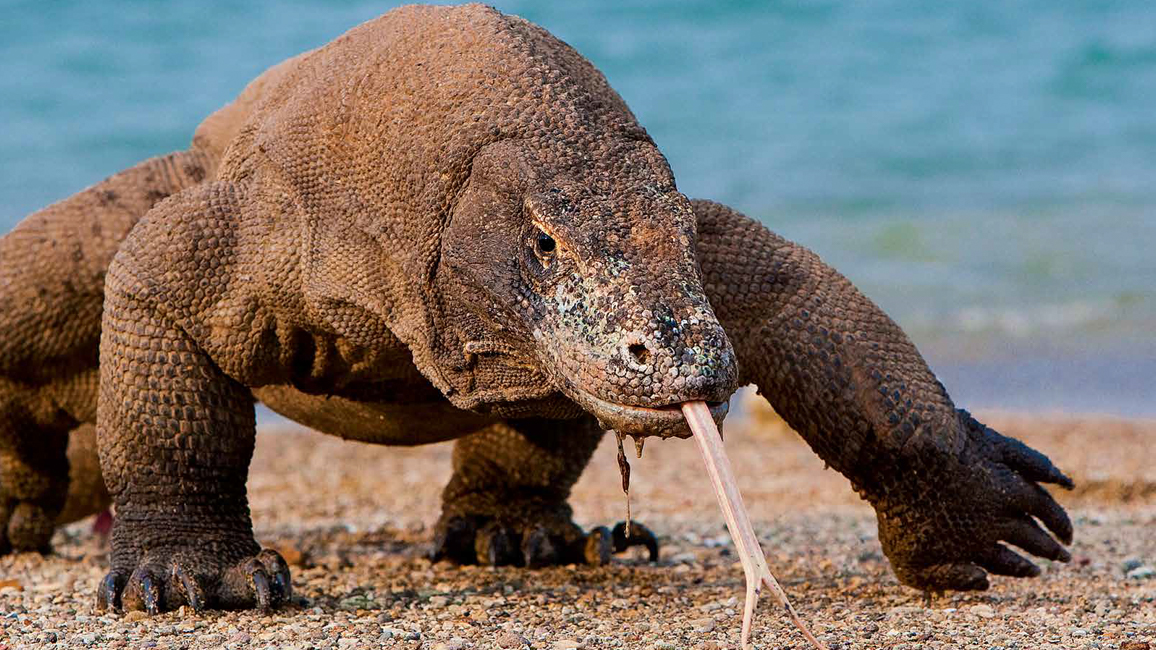
Komodo Dragons
By Marty CrumpThousands of years ago, some ancient sailors and traders visited faraway islands in the Indian Ocean. Imagine their surprise—and horror—when they saw reptiles like this one, nearly the size of gators.
They probably returned home and told tales of monsters that flicked long, forked tongues in and out of drool-dripping mouths. These huge beasts might even have inspired stories of imaginary fire-breathing dragons.
Komodo (kuh-MOH-doh) dragons are lizards—the largest lizards in the world. An adult can be 10 feet long. Four large dragons placed end to end would equal a T. rex from tip to tail. But don’t worry: These wild dragons live only on a few small islands within the country of Indonesia (see map).
WHAT’S ON THE MENU?
Komodo dragons eat just about any meat they can find—dead or alive—from rats to deer to huge water buffalo. They even eat cobras—and each other! And they have nasty dining manners. They slurp, slobber, and stuff their big mouths. A large dragon can devour an entire boar (wild pig) in less than 20 minutes. How piggish!
Often dragons just lumber up and down the beach, eating dead fish and turtles. But they also can run for short distances, chasing down fast-moving prey such as lizards.
DRAGON’S TOOL BOX
A Komodo dragon is well equipped for its life as a meat-eater. On the lookout for food, the dragon darts a long, forked tongue in and out of its mouth. The tips of the tongue pick up scents from the air. The dragon pokes the tongue tips into two pockets in the roof of its mouth. Nerves there sense any odors and tell the dragon whether a meal is near.
METHODS TO LIVE BY
Sometimes dragons sneak up on their prey, such as a deer asleep under a bush. Other times they ambush prey. Picture this: a large Komodo dragon lies in wait along a forest trail. As a wild boar approaches, the dragon lunges at it and bites.
Injured prey might manage to get away—but not for long. Within a few days, the wounded animal dies and its carcass begins to rot. Komodo dragons can smell the stink from several miles away. FOOD! They gather at the spot and the feast begins.
But dragons don’t dine every day, as you do. On average, an adult gets only one large meal a month. But when it does eat, it eats a lot! Its stomach expands so much that a dragon can take in most of its body weight in a single meal. That would be like you chowing down four or five whole turkeys—by yourself—for Thanksgiving dinner!
Unlike you, dragons don’t leave behind bones, fat, skin, and gristle. They devour all those parts, plus fur, feathers, hooves, and horns. Slimy saliva helps large chunks slide down the throat. For a Komodo dragon, drool is cool!
JAWS OF DOOM
Did you ever hear the term “dragon breath”? Perhaps it comes from Komodo dragons. A dragon’s deadly drool may contain over 50 kinds of harmful bacteria (germs)—and it really stinks! The lizard also has venom glands in its jaws. The venom probably makes bitten prey go into shock—and then bleed to death.
THE NEXT GENERATION
Komodo dragons usually live alone—until it’s time to find a mate. After mating, each female buries up to 30 eggs in the sand. Then, in about eight months, miniature dragons break through their eggshells. Now completely on their own, they face a world full of hungry predators—including their elders—ready to eat them.
THE FUTURE?
Most of the remaining 3,000 or so Komodo dragons are protected in Komodo National Park. But sadly, some people who live there still kill dragons out of fear or because the lizards eat their goats and chickens. People also destroy parts of the forest and kill deer that the dragons need for food.
Scientists are working to better understand what Komodo dragons need to survive. With more protection, these awesome reptile giants should still be able to rule their islands for the next century and beyond.
“Dragon!” originally appeared in the November 2013 issue of Ranger Rick magazine.
(Click on each image above for a closer view of the story.)



















